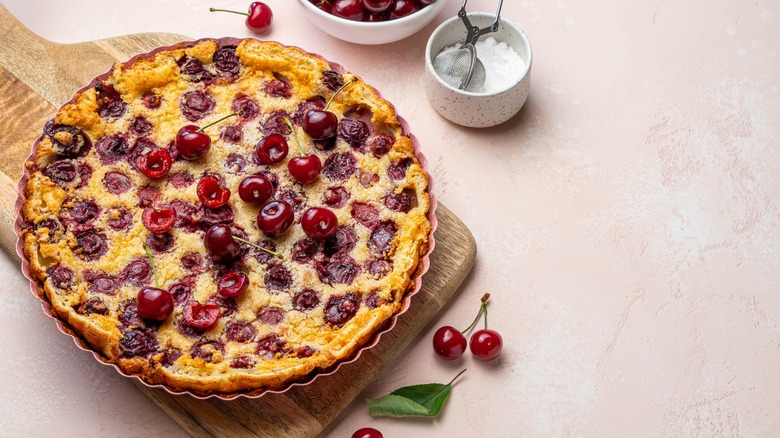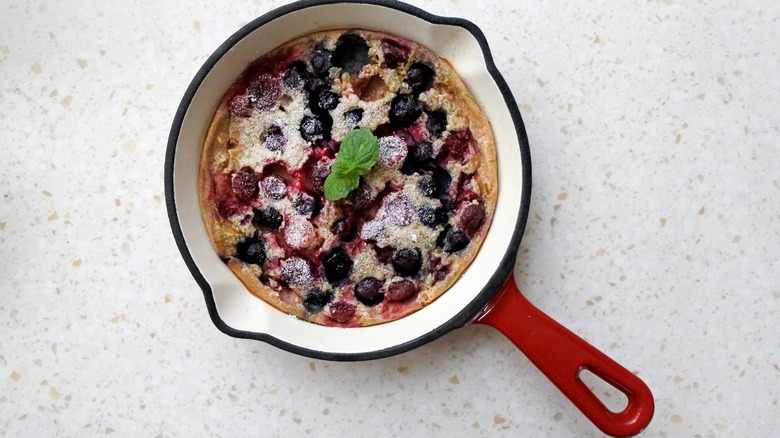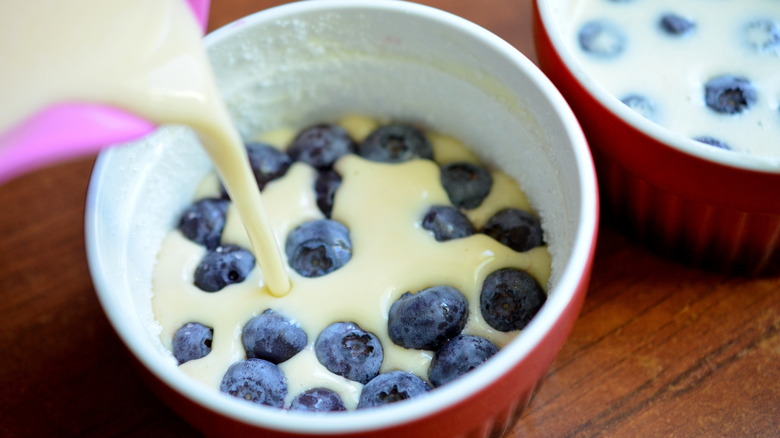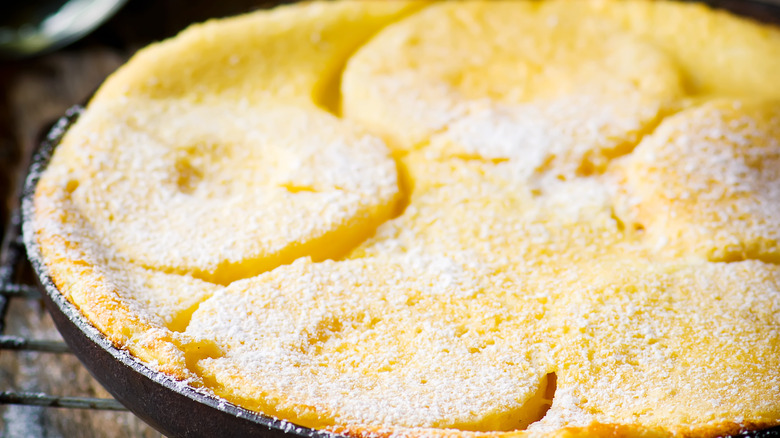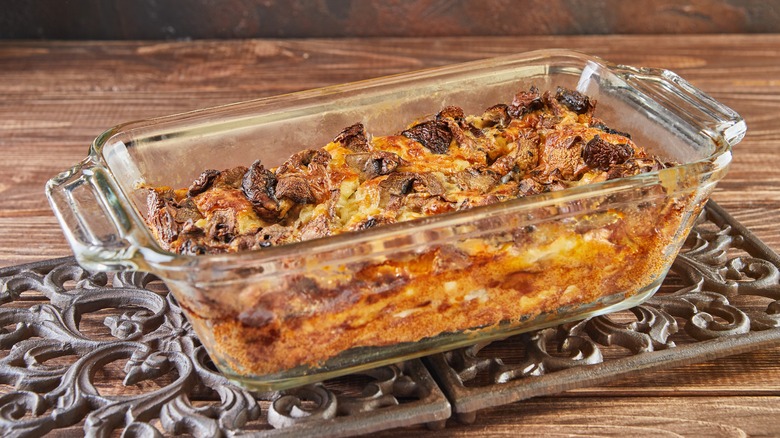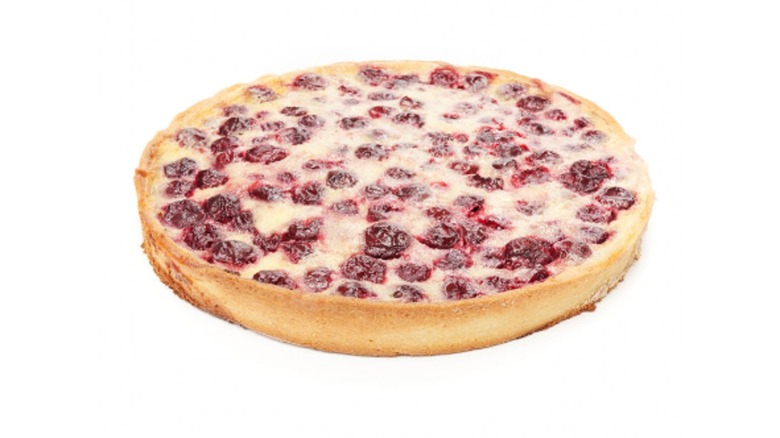What Is Clafoutis And How Do You Eat It?
Clafoutis, which is both a singular and plural term, is essentially a big, fat, oven-baked pancake. The word and the dish both come from France, which means that you do not pronounce the "s" at the end — the proper way to say it is cla-foo-tee. You may sometimes see it spelled as clafouti, too, but this term is also singular and plural and the pronunciation is the same. Clafoutis is most commonly made with cherries (black cherries, for preference) and is generally seen as a dessert although its pancake-like appearance and consistency mean that it can also double as a breakfast dish.
As to how you eat clafoutis, a fork is suggested, although you could also use a knife if you wish to cut your piece up into precise bites. A plate comes in handy as well, although eating out of the pan is permissible if there are no witnesses. Clafoutis typically requires no topping apart from a dusting of powdered sugar, but some cooks like to gild the lily with the addition of whipped cream or ice cream. If you are bucking tradition to the extent of eating clafoutis as a morning meal, you can even drizzle it with pancake syrup. (Don't post pics, though, as you won't want a citation from les gendarmes de cuisine.)
History of clafoutis
As clafoutis seems to be a type of peasant dish rather than one that was created in a palace kitchen, we don't have an exact date or a name to attach to it. But we do have a place: Limousin, a region in the south of France whose name is now a generic term for luxury automobiles despite its not being known for producing them. Still, we could always consider clafoutis to be the Cadillac of oven pancakes (it's a stretch, we know).
By the 1800s, clafoutis was something that was known throughout France and thrifty French householders may well have made use of the recipe to use up surplus summertime fruits. The name itself comes from a word in the Occitan dialect (also known as Languedoc), that word being "clafotis." The word means "to fill," and refers to the fact that making the dish involves first filling a pan with fruit and then filling in all the gaps with the batter that will bake up into this rustic pastry.
How clafoutis is made
If you want to flex about French cooking but you lack the requisite skills to make a complicated pastry such as mille feuille, you'll be relieved to know that clafoutis is no more complicated than making pancakes. Less so, in fact, since you don't have to fry up batch after batch but can instead let the oven do the heavy lifting. (If you have your heart set on those mille feuilles, though, we have a shortcut recipe that simplifies things to some extent.)
Clafoutis 101: Cut up your fruit. Peel if necessary (this is highly advisable if you're going with bananas, less so if you opt for strawberries) and remove all other inedible bits, unless you're going old-school French style with cherries, in which case you'll need to leave the pits in. (Seriously, some people do this to provide extra flavor, although it must make for a slightly challenging eating experience.) Arrange the fruit in a baking pan. Make a batter out of eggs, butter, sugar, flour, baking powder, salt, and maybe a dash of flavoring extract such as almond or vanilla, then pour the batter over the top of the fruit. Bake the clafoutis until it gets all puffy, sprinkle some powdered sugar over the top, then cut it up in wedges like a pie or cake. That's the gist of it, but if you'd like more precise instructions, here's our cherry clafoutis recipe to use as a template for your own clafoutis creations.
Most clafoutis is fruity
The traditional clafoutis may be made with cherries (pits and all) — even the dictionary acknowledges this. Clafoutis purists even coined a word for non-cherry versions of the dish, insisting they be designated as flaugnardes instead of true clafoutis. (Flaugrarde is a Frenchified version of an Occitan word meaning soft.)
In support of the position that clafoutis can be made with any fruit, however, we call as a witness for the defense one Julia Child, the Californian-born chef whose name has nevertheless become synonymous with French cooking (at least in America, if not France). Child has a recipe for clafoutis made with blueberries or blackberries, so if we can accept this berry clafoutis (and we most definitely can), we'll happily acknowledge plum, peach, pear, apple, and mango clafoutis. We'll even welcome tropical pineapple-coconut clafoutis (add a touch of rum extract and you'll have a pina colada in pancake form). Raisins and nuts, while not typically standalone main ingredients for clafoutis, can also be paired with fruits in delightful combos like apple walnut or cherry almond clafoutis.
Savory clafoutis exists, as well
Cherry-only clafoutis fanatics must really get their toques in a twist over a relatively new phenomenon, that of savory clafoutis. Savory clafoutis seem to have taken off in the mid-20-teens, aka the peak hipster food era, which checks out. The idea, however, isn't all that avant-garde once you realize that crepes, which are a different French take on the pancake, also come in both sweet and savory varieties.
Among the savory clafoutis recipes we've seen are ones for corn with chard and cheese (this one's for alliteration lovers), parmesan and mushrooms, zucchini and goat cheese, and spinach and feta. Meaty clafoutis, too, can be a thing, such as ones made with curried chicken, bacon and cheddar, or duck breast with gorgonzola. We've yet to see too many sweet-and-savory mashup clafoutis, but these could be quite interesting. Imagine a Monte Cristo-inspired clafoutis made with ham, Swiss cheese, and powdered sugar-sprinkled strawberries or perhaps a canard aux cerises clafoutis that combines two classic French dishes in one (avec allitération!). In the words of Jean-Luc Picard, himself a (fictional) Frenchman, "Make it so!"
Where to buy clafoutis
Clafoutis is something that you're likely to find numerous recipes for should you go Googling. The search engine, however, is far less likely to bombard you with places where you can purchase the stuff. This may be due in part to the fact that it's fairly easy to make, but then, so is garlic bread and that stuff's all over the place in supermarkets. One small regional chain, Kings Food Markets, does carry clafoutis, however (in a berry version, no less).
Clafoutis is also available in a number of bakeries and restaurants, although a surprising number of these stick to the traditional cherry kind. This includes Maison Mulot, an establishment that some have called one of Paris' premier pâtisseries. Closer to home, Chicago's Bittersweet Pastry also makes its more cake-like clafoutis with cherries, although it also adds almonds, while Bartolotta's Lake Park Bistro in Milwaukee Americanizes its cherry clafoutis with a scoop of bourbon-flavored ice cream. Ontario's Le Délice, however, sells raspberry clafoutis, while Bonpastry in Carlsbad, California offers one made with pears and yogurt. (While the bakery calls it a cake, this ingredient combo sounds like a healthy breakfast to us.) Too bad IHOP never added a certain fat French pancake to the menu because then it could have offered Rooty Tooty Fresh 'N Fruity Clafouti.
